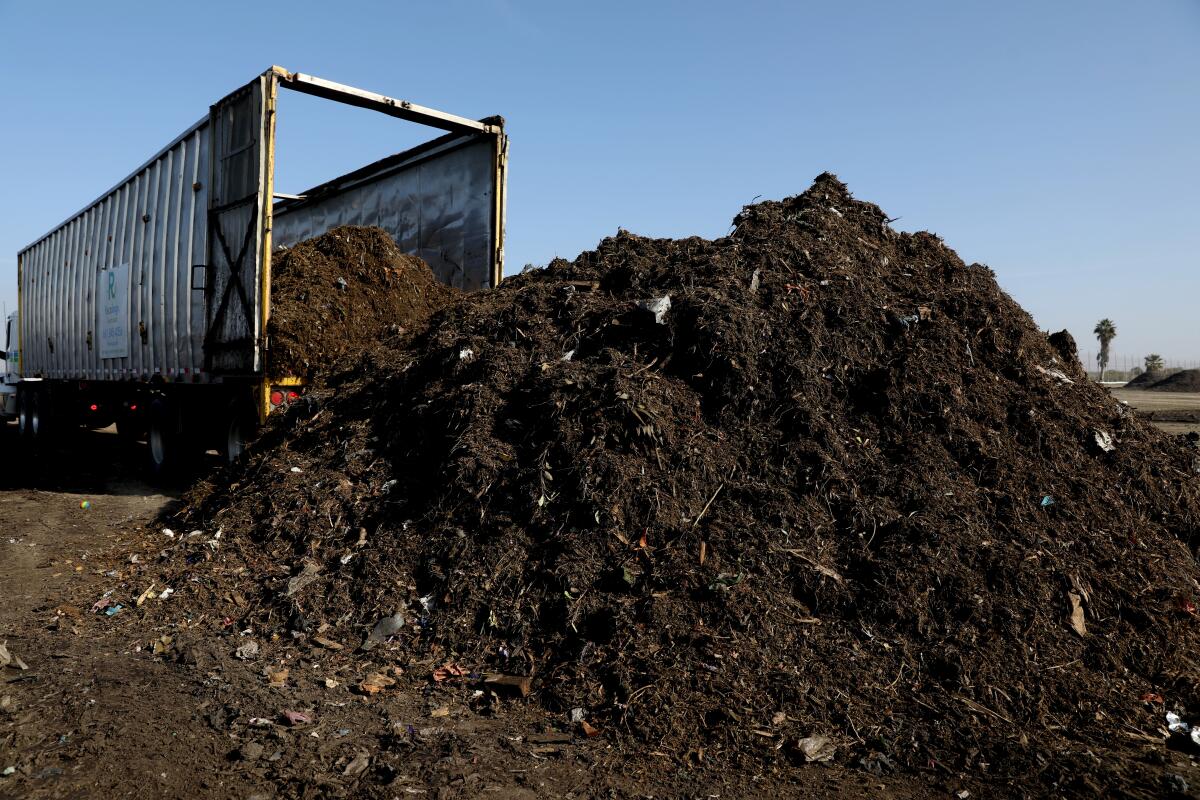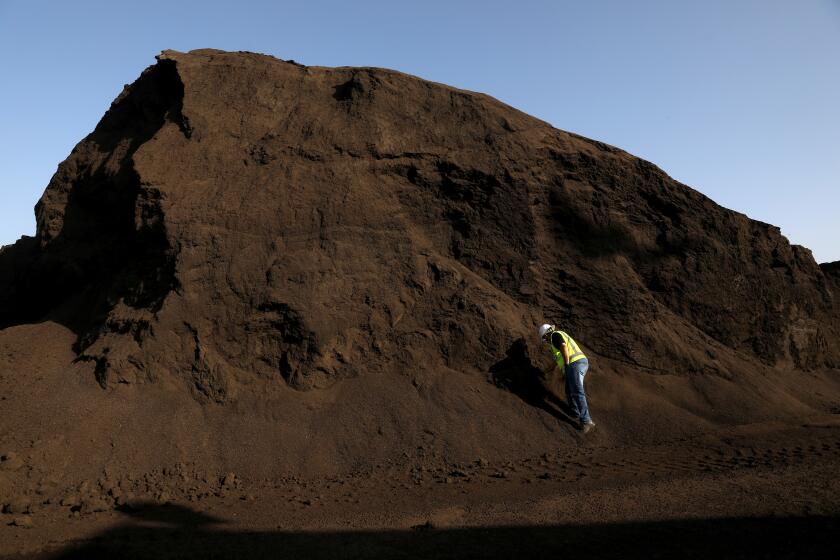What you need to know about California’s new composting law — a game changer for food waste

- Share via
Californians will ring in the new year with the unfurling of a groundbreaking law that will change how they dispose of their organic waste, particularly leftover food and kitchen scraps.
Senate Bill 1383 requires all residents and businesses to separate such “green” waste from other trash, but the program will be rolled out gradually for homes and businesses in the coming months, with the actual startup date varying, depending on the location of your home or business.
Fines can be levied for failing to separate organic refuse from other trash. But those charges aren’t scheduled to begin until 2024. CalRecycle, the state agency overseeing the change, has lots of information about the new requirements on its website.
Others offering composting solutions include LA Compost — which gives instructions on home composting and also offers community hubs where organic material can be dropped — and CompostableLA, which provides a home pickup service in some neighborhoods, for a fee.
Residents and businesspeople should check with their local governments, and with waste haulers, to find out the specific rules for their communities. Here are some frequently asked questions about the new requirements, with answers from Los Angeles County Public Works and the Los Angeles City Bureau of Sanitation.
Isn’t garbage just garbage? Why are California lawmakers requiring us to separate organic waste from the rest of our trash?
Scientists have found that organic waste dumped into traditional landfills decomposes and creates methane, a super-pollutant with as much as 80 times the Earth-warming potency of carbon dioxide.
To slow the advance of global warming, the state wants to redirect the material to composting centers or anaerobic digestion facilities, where it can help sink carbon back into the Earth or capture natural gas to — for instance — power trash trucks.
Those banana peels, pizza boxes and coffee grounds you throw away? Starting Jan. 1, local government will need to start composting them, in part to reduce greenhouse gases.
When do I need to begin separating my kitchen waste from other trash?
The opening date for organics diversion varies, depending on where you live. San Francisco, Berkeley, Costa Mesa and other communities have been recycling kitchen waste via curbside green bins for years. Those bins also accommodate yard trimmings.
Los Angeles County Public Works officials say homes in unincorporated communities will get notices over the first half of 2022 telling them when, and how, to segregate their food waste. Some businesses in L.A. County already have voluntary recycling of food waste, a program that will become mandatory over the course of the new year.
In the city of Los Angeles, the Bureau of Sanitation plans to present a plan early next year to expand food waste recycling from 18,000 homes now in a pilot program to the remaining 730,000 customers. That curbside program should begin by next summer. In the meantime, residents can throw kitchen waste in their regular trash bins, to be hauled to the landfill. They also have the option of composting in their yards, though the COVID-19 pandemic has led to the shutdown of city composting workshops (and the discounted composting bins that went with them).
In March, the Bureau of Sanitation plans to work with a nonprofit to collect food scraps at 25 neighborhood farmers markets and composting centers. Those locations will be announced later.
What if I live in an apartment building or condo complex?
In unincorporated communities in L.A. County, the rules for multifamily housing are still being finalized. It’s expected that at least some waste haulers will continue to allow food waste to be mixed with other trash, to be separated later at processing facilities so it can be recycled.
In the city of Los Angeles, multifamily units handled by service providers under the recycLA program are now encouraged to recycle food scraps. Residents need to contact their service provider to subscribe to the program.
Can’t climate-warming gases also be curtailed by simply reducing food waste?
Yes. Keith Lilley, deputy director of Los Angeles County Public Works, urges residents and businesses to “shop purposefully, store food mindfully, preserve food and learn how to manage excess food.”
The world wastes more than 1 billion tons of food every year, according to the U.N. That’s 17% of total food available to consumers.
Are there alternatives to having the kitchen and yard waste trucked away?
Yes. Food scraps can be composted at home or taken to friends or family who compost or to a community compost location. L.A. County offers free webinars at smartgardening.com to teach residents how to practice backyard and worm composting on their own. Discounted compost bins are sold via the webinars.
What about food that’s still edible? Where should it go?
SB 1383 proposes that by 2025, the state must recover for people to eat 20% of edible food that would have gone to landfills. Regulations to meet that goal focus on supermarkets and other large food providers. (The rules do not force residents or small businesses to recycle edible food.) The surplus goes to food banks. Businesses can learn more about donations by visiting FoodDropLA.com.
Once my local waste hauler gives the green light, will fruits and vegetables be the only appropriate food waste for the green bin?
No. L.A. County says “all possible parts of food will be acceptable,” including cooked meat, bones, fish, soups and small amounts of grease. Properly licensed anaerobic digesters will be able to break it all down, while also killing pathogens. City sanitation officials agree that — once their curbside pickups begin — all food waste will be acceptable.
In L.A., some residents have already been putting food scraps in their existing green bins intended for yard waste, even though the Bureau of Sanitation says that’s a no-no and that the kitchen waste will be landfilled. Once the city rolls out its program, it’s expected both food and yard waste will be permitted in the green bins.
What if I run a restaurant and have a lot of grease?
That should go to a cooking oil and grease recycler. L.A. County lists those here.
Where should I store my kitchen waste and how do I make sure it doesn’t stink?
Local governments and waste haulers recommend gathering the scraps in kitchen pails, which both L.A. city and county plan to distribute. Frequent emptying (and cleaning) of the pails should limit odors. Some users say lining them with paper towels also soaks up liquid that can raise a stink. The city of Los Angeles suggests two other odor-reducing techniques: layering food waste with yard trimmings or freezing food scraps in a reusable container prior to collection day.
Can I be penalized if I dump my waste in the wrong place?
Yes. Beginning in 2024, state law will allow fines for those who contaminate their organic waste. A first offense could cost you $50 to $100, with third and subsequent offenses costing up to $500.
L.A. city sanitation officials said their “ambassadors” will notify those not in compliance and impose penalties only as a last resort.
What happens to the kitchen scraps that go down the garbage disposal in my sink?
Wastewater plants in L.A. County have the ability to harvest biogas from sewage sludge and food waste. The gas can be burned for electricity or turned into vehicle fuel.
But the bureaucrats who handle your refuse don’t want too much waste in the drain because of limited sewer capacity. They say it’s more efficient to have the food waste composted or hauled away.
The city of L.A. recommends putting only smaller fruit and vegetable scraps in the disposal.
A new report lays out a blueprint to cut food loss and waste in half by 2030. Doing so could reduce greenhouse gas emissions by 1.5 gigatons per year.
Where will all this extra food waste go?
Most will go to large composting centers or to plants that will convert it into natural gas. Los Angeles County alone has projected that about 1.9 million tons of food waste a year will be diverted. It could take a dozen anaerobic digestion plants to process all of that, at a projected cost of $840 million.
Who’s going to pay for all this?
You are. A survey by the League of California Cities found that most local governments expect refuse collection rates to increase less than 20%, with 1 in 5 cities saying they expect charges to go up more. Costa Mesa, an early adopter of curbside green recycling, estimates that over nine years, monthly rates will have risen a total of $6.10, to $24.10 a month, by 2023-24.
More to Read
Sign up for Essential California
The most important California stories and recommendations in your inbox every morning.
You may occasionally receive promotional content from the Los Angeles Times.

















